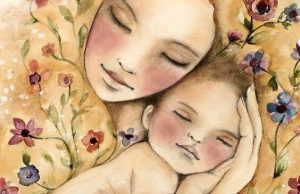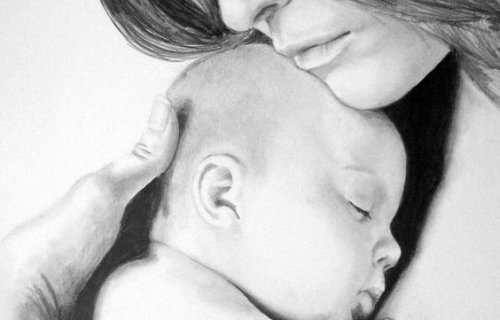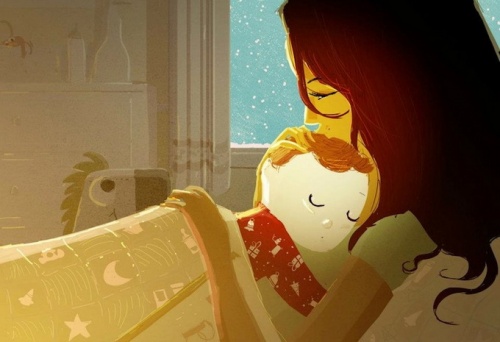My Baby Only Sleeps in My Arms


Written and verified by the psychologist Valeria Sabater
My baby only sleeps in my arms. Is this a bad thing? Many babies are like this: they associate their mother’s arms with peace, closing their eyes and sleeping. Seconds later, when we try to take them to their crib, they wake up again as if they are in a strange and annoying place.
In the opinion of many pediatricians, it may be inappropriate for a baby to associate rest exclusively with the arms of their mom or dad. However, there are many nuances that should be understood in order to reach a clear and objective conclusion, because when it comes to a child’s sleep, all we need is time, patience and a lot of love.
My baby only falls asleep in my arms… is something wrong?
We will begin by clarifying something important: no, there is nothing wrong with your baby if he is less than 6 months old and falls asleep only in your arms. At this age, rituals and habits acquire a key importance, and it is the time to settle small behaviors.
If you do not practice co-sleeping, it would be appropriate for a 6-month-old to be able to sleep in a crib and associate this place as a space to wake up and fall asleep in every day. Now, that does not mean you can’t go to him when he needs you, pick him up, give him the security of your arms and then leave him in his crib again.
Let’s see more important data below.

Until 6 months, they just need to feel safe
We must be aware that a child’s brain will not be mature until about 7 years of age. The first mature leap happens at 3 years, when many of the neural networks are covered with myelin and the electrical patter allows them to regulate their sleep cycles.
So, we must understand that it’s normal for a child to wake up several times at night. However, it’s ideal to integrate routines and good habits as soon as possible.
- Up until 6 months of age, all a baby needs is to feel safe. The only way this can be achieved is by feeling your warmth.
- Your baby spent 9 months in your womb, protected and isolated from the outside world that seems so threatening. He interprets leaving him in a crib as abandonment.
- It is also necessary to know that every child will have unique needs. There will be babies who take to the crib with no problem, and there will be others who are more dependent and need more physical contact.
So, do not worry if your baby only sleeps in your arms. This does not mean that he will have problems with independence in the future. The two are unrelated. Up until 6 months of age, all you can do is wait until he is deeply asleep and then leave him in the crib.
Strategies to help your baby sleep in a crib
As we have previously mentioned, the most important thing is to establish habits in your child as soon as possible. Therefore, it is advisable to take into account the following tips:
Teaching him to sleep in the crib does not mean giving up affection
If you decide not to practice co-sleeping, your child should get used to sleeping in a crib. It will be good for both of you to have a habit and routine. Do not hesitate to establish these useful behaviors:
- A bath before sleeping
- Feeding him without forcing him too much. You do not have to fight with him at this time if he does not feel like it
- Leave him in the crib while you caress him affectionately for as long as necessary until he closes his eyes
- Help him know that you are there

Leave a garment that carries your smell
- Another good technique for helping your baby take to the crib without trauma and to sleep in it is to leave behind a garment that carries your smell.
- This is one way to provide security. Just leave him in the crib and caress him to let him know you are with him. Leave the garment under his head and be patient as he falls asleep.
- Smell is one of the most highly developed senses in babies under 6 months, so we have this magnificent opportunity that is worth taking advantage of.
Do not force behavior: patience and affection are key
There are moms and dads who get desperate when they see that their babies only sleep in their arms. When they are taken to the crib, they wake up and do not sleep again. The parent’s anxiety ends up being felt by the child himself.

- Sleep is not a behavior that can be taught like reading. It is an instinctive behavior, and during the first few months, a baby will only fall asleep when he feels safe and unafraid.
- Week by week, those fears will disappear, and little by little, the baby’s need for attachment will not be so pronounced. So do not worry. Nothing will happen if you nap with him or if he sleeps with you one night in bed.
Over time, he will reclaim his space and regulate his sleep.
My baby only sleeps in my arms. Is this a bad thing? Many babies are like this: they associate their mother’s arms with peace, closing their eyes and sleeping. Seconds later, when we try to take them to their crib, they wake up again as if they are in a strange and annoying place.
In the opinion of many pediatricians, it may be inappropriate for a baby to associate rest exclusively with the arms of their mom or dad. However, there are many nuances that should be understood in order to reach a clear and objective conclusion, because when it comes to a child’s sleep, all we need is time, patience and a lot of love.
My baby only falls asleep in my arms… is something wrong?
We will begin by clarifying something important: no, there is nothing wrong with your baby if he is less than 6 months old and falls asleep only in your arms. At this age, rituals and habits acquire a key importance, and it is the time to settle small behaviors.
If you do not practice co-sleeping, it would be appropriate for a 6-month-old to be able to sleep in a crib and associate this place as a space to wake up and fall asleep in every day. Now, that does not mean you can’t go to him when he needs you, pick him up, give him the security of your arms and then leave him in his crib again.
Let’s see more important data below.

Until 6 months, they just need to feel safe
We must be aware that a child’s brain will not be mature until about 7 years of age. The first mature leap happens at 3 years, when many of the neural networks are covered with myelin and the electrical patter allows them to regulate their sleep cycles.
So, we must understand that it’s normal for a child to wake up several times at night. However, it’s ideal to integrate routines and good habits as soon as possible.
- Up until 6 months of age, all a baby needs is to feel safe. The only way this can be achieved is by feeling your warmth.
- Your baby spent 9 months in your womb, protected and isolated from the outside world that seems so threatening. He interprets leaving him in a crib as abandonment.
- It is also necessary to know that every child will have unique needs. There will be babies who take to the crib with no problem, and there will be others who are more dependent and need more physical contact.
So, do not worry if your baby only sleeps in your arms. This does not mean that he will have problems with independence in the future. The two are unrelated. Up until 6 months of age, all you can do is wait until he is deeply asleep and then leave him in the crib.
Strategies to help your baby sleep in a crib
As we have previously mentioned, the most important thing is to establish habits in your child as soon as possible. Therefore, it is advisable to take into account the following tips:
Teaching him to sleep in the crib does not mean giving up affection
If you decide not to practice co-sleeping, your child should get used to sleeping in a crib. It will be good for both of you to have a habit and routine. Do not hesitate to establish these useful behaviors:
- A bath before sleeping
- Feeding him without forcing him too much. You do not have to fight with him at this time if he does not feel like it
- Leave him in the crib while you caress him affectionately for as long as necessary until he closes his eyes
- Help him know that you are there

Leave a garment that carries your smell
- Another good technique for helping your baby take to the crib without trauma and to sleep in it is to leave behind a garment that carries your smell.
- This is one way to provide security. Just leave him in the crib and caress him to let him know you are with him. Leave the garment under his head and be patient as he falls asleep.
- Smell is one of the most highly developed senses in babies under 6 months, so we have this magnificent opportunity that is worth taking advantage of.
Do not force behavior: patience and affection are key
There are moms and dads who get desperate when they see that their babies only sleep in their arms. When they are taken to the crib, they wake up and do not sleep again. The parent’s anxiety ends up being felt by the child himself.

- Sleep is not a behavior that can be taught like reading. It is an instinctive behavior, and during the first few months, a baby will only fall asleep when he feels safe and unafraid.
- Week by week, those fears will disappear, and little by little, the baby’s need for attachment will not be so pronounced. So do not worry. Nothing will happen if you nap with him or if he sleeps with you one night in bed.
Over time, he will reclaim his space and regulate his sleep.
All cited sources were thoroughly reviewed by our team to ensure their quality, reliability, currency, and validity. The bibliography of this article was considered reliable and of academic or scientific accuracy.
- Cuidados y caricias. (2017). Mi bebé solo se duerme en brazos y cuando lo acuesto de despierta ¿Es normal? Recuperado el 2 de enero de 2022 de: Disponible en: https://www.cuidadosycaricias.es/bebe-solo-se-duerme-en-brazos/
- Dawson, G., Ashman, SB y Carver, LJ (2000). El papel de la experiencia temprana en la configuración del desarrollo conductual y cerebral y sus implicaciones para la política social. Desarrollo y psicopatología , 12 (4), 695-712. Disponible en: https://www.researchgate.net/publication/12129242_The_Role_of_Early_Experience_in_Shaping_Behavioral_and_Brain_Development_and_Its_Implications_for_Social_Policy
- GuijarroEM (2013). Lactancia materna y revolución, o la teta como insumisión biocultural: calostro, cuerpo y cuidado. Dilemas , (11), 169-206. Disponible en: https://dialnet.unirioja.es/servlet/articulo?codigo=4195869
- Haghayegh S., Khoshnevis S., Smolensky MH, et al. (2019). Calentamiento corporal pasivo antes de acostarse mediante una ducha o baño tibios para mejorar el sueño: una revisión sistemática y un metanálisis. Revisiones de medicina del sueño , 46 , 124-135. Disponible en: https://pubmed.ncbi.nlm.nih.gov/31102877/
- Observatorio de salud de la mujer de Harvard. (2010, 1 de diciembre). Los beneficios para la salud de las relaciones sólidas. Recuperado el 3 de agosto de 2016 de: https://www.health.harvard.edu/newsletter_article/the-health-benefits-of-strong-relationships
- Larrea A. (2017). Análisis de las técnicas para el manejo del sueño en niños de 0 a 2 años y del conocimiento de los padres sobre las mismas. [Trabajo de grado, Universidad Pública de Navarra]. Academia-e. Disponible en: https://academica-e.unavarra.es/handle/2454/26668
- Clínica Mayo. (2022, 23 de abril). Cómo ayudar a que el bebé duerma toda la noche. Recuperado el 7 de marzo 2022 de: https://www.mayoclinic.org/es-es/healthy-lifestyle/infant-and-toddler-health/in-depth/baby-sleep/art-20045014
- Mindell J. A., Williamson A. A. (2018). Benefits of a bedtime routine in young children: Sleep, development, and beyond. Sleep medicine reviews, 40, 93-108. Disponible en: https://www.ncbi.nlm.nih.gov/pmc/articles/PMC6587181/#:~:text=As%20the%20number%20of%20nights,consistency%20in%20conferring%20sleep%20benefits.
- Rigon E. & Auffret M. (2016). ¿Hay que coger al bebe en brazos cuando llora? Editorial Parkstone International. Disponible en: https://books.google.at/books?id=ZXJrDQAAQBAJ
- Vives RJ, Lartigue, BT y Córdoba, A. (1992). Apego y vínculo. Comunicación preliminar. Cuaderno Psicoanal , 25 , 45-53. Disponible en: http://bloguamx.byethost10.com/wp-content/uploads/2015/04/apego-y-vinculo-lartigue.pdf?i=1
- Wright J. (2023). Cómo conseguir que un bebé duerma en una cuna. WikiHow. Recuperado el 7 de marzo de 2023 de: https://www.wikihow.life/Get-a-Baby-to-Sleep-in-a-Crib
This text is provided for informational purposes only and does not replace consultation with a professional. If in doubt, consult your specialist.








